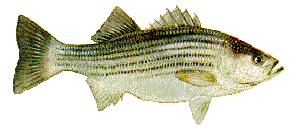|
|
|

| When | Where |
| Baitfishing | Lure Fishing |
| About stripers... |
 River
Herring
River
Herring
So how do you get these baitfish? They don't sell them at the bait store so you'll have to catch them. Since these baits usually go between 6 and 12 inches, this alone can provide enough action for a day's fishing! A simple spinning outfit with a 1/2 oz. sinker and a 1" gold, chartreuse, or silver "willow leaf" bait is adequate for catching alewives. Or you can try a silver or gold phoebe. The bait stores on the river will have plenty of both.
Another popular method for catching alewives is by netting them. Since the regulations change annually, be sure to check the latest Connecticut Angler's Guide.
Keep the alewives alive in your livewell or hang them in a container over the boat. Remember that they need plenty of oxygen and a current to survive. Once you have your bait, the rest is easy!! Hook the alewife or herring with a 3 or 4/O hook, let him swim about 15 feet from the boat and drift like that downstream. Believe Me it won't be long before your rod is doubled over and the drag is singing!
Drift by structure, such as deeper pockets and sandbars. These areas hold stripers all day. Let the alewife or herring drift naturally over the hole. This is a deadly bait fishing technique for river bass. A big striper will rise out of the deepest pocket to snatch a live bait.
One particular place I fish is an old stone wall that protrudes into the river. A deep hole exists before it as a result of the rolling current. It is a striper haven! The river goes from 6 to about 15 feet deep and its only about a 30X30 yard stretch of river. I give this area special attention especially on bright, hot days in May.
Shallow running crankbaits that imitate an alewife or herring in a 6 inch size are also a good bet, but one of the greatest thrills is seeing a huge striper hammer a topwater popper. I like a 6 or 7 inch silver pencil popper or similar lure. Give the lure an erratic action using swift jerks. Cast the lure diagnolly upstream and work the lure down. A striper may just inhale the bait with a swirl or engulf the whole thing in a breathtaking explosion. One thing remains constant: it is one of the most super fish in the world to take on a topwater lure.
Some boats like to troll umbrella rigs but I find this difficult in the river since the bottom is constantly changing. If you're going to troll, try the shallow running crankbait or a rigged herring. Concentrate around deeper holes and bridges. Stick near the edges if you're plowing up the channel.
No doubt the best time to do some topwater or any other lure fishing is first thing in the morning, right before dark, and throughout the night. The bass are hunting vigorously now and have difficulty differentiating real fish from real metal. During the peak of the run, you can score big lure fishing for these stripers during these hours.
Stripers will eat just about anything they can put in their mouths. Although they generally prey on fish, squid, and crabs, everything from cigarette lighters to sea birds have been found in the striper's stomach. They prefer a violent, turbulent environment such as rocky seashore, rips, breakwaters, and crashing waves. The wise angler will look for them here. The river in the spring is the exception to this rule.
They are an excellent table fish with a delicate white meat that is delicious when prepared right. I consider the striper one of Connecticut's greatest natural resources. Anyone who has had one on the end of a line or the end of a fork can clearly see why.
The striped bass run in the Connecticut River each year is a unique, fascinating, beautiful phenomenon that should be respected and held in high regards by people who fish it. All I ask is that you catch your limit; but limit your catch. Follow the rules in the Connecticut Angler's Guide so that we can enjoy this experience forever.